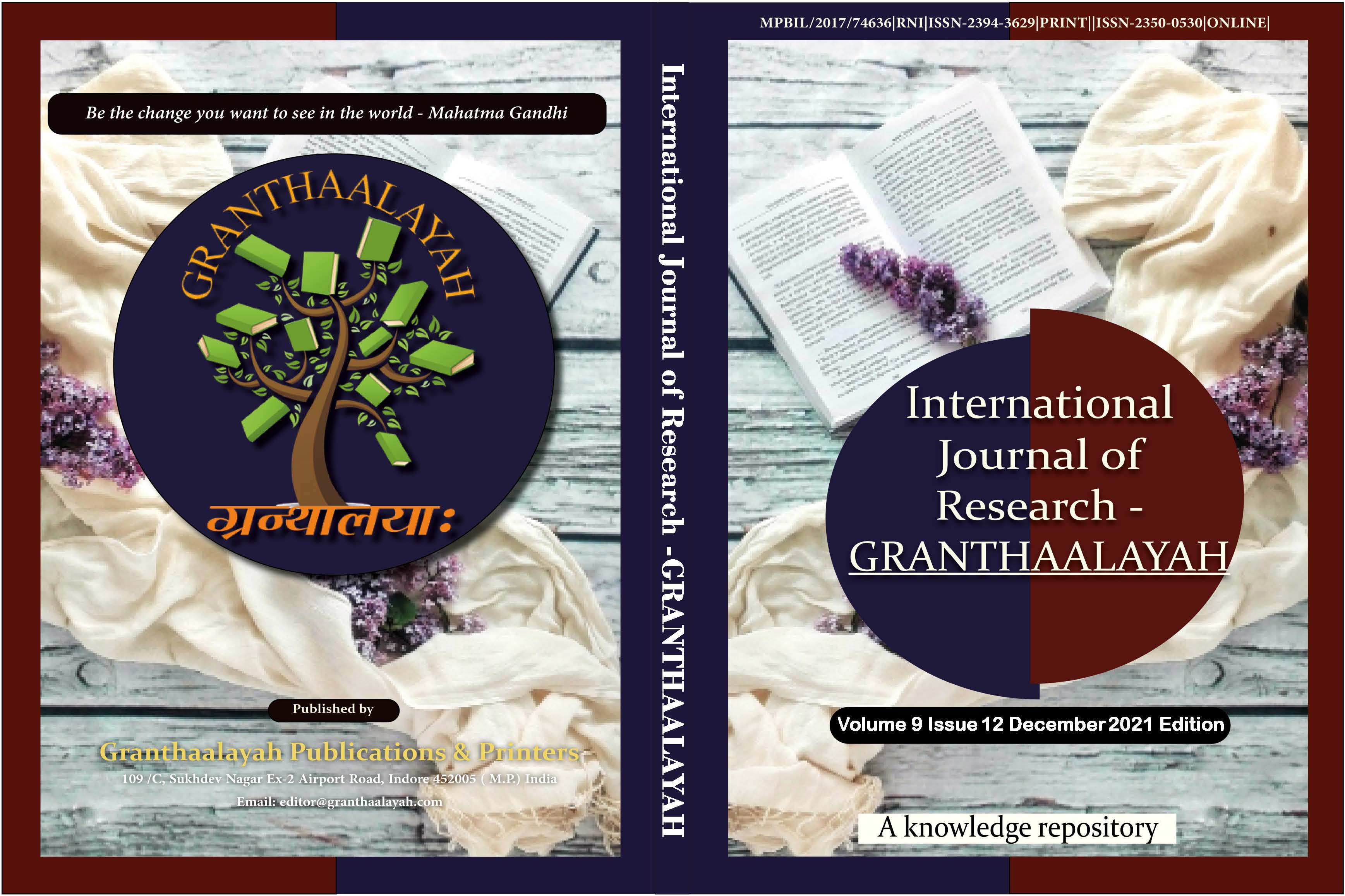ASSESSMENT OF EXISTING AGROFORESTRY PRACTICES IN WEST HARARGHE ZONE OF OROMIA REGION, ETHIOPIA
DOI:
https://doi.org/10.29121/granthaalayah.v9.i12.2021.4436Keywords:
Existing Agroforestry Practices, Multidimensional Utilizes Of Trees/Shrubs, Woody SpeciesAbstract [English]
A study was conducted in west Hararghe zone, on three districts, in six peasant associations with the intention to identify and assess potentials, constraints, opportunities and farmers’ perception on the existing agro-forestry practices of the study areas. The study was multistage sampling methods in which 121 households were selected using random sampling technique. Qualitative data generated by conducting household survey interviews, focus group discussions, key informant interview, and direct field observations in order to fit intention of the study. The collected Data was manipulated using suitable analytical software packages (SPSS, V.20) to calculate percentage and frequency of events through descriptive statistics. Based on the respondents idea across the districts, an average value of home garden agroforestry practices with 86% increasing and 11.5% decreasing and 2.5% no change trends were observed; while alley cropping of agroforestry practice during the past ten years ago with 89.3% increasing and 10.7% decreasing trend was observed (Table 4). Almost all in both Hararghe zones; alley cropping system is the most familiar than other existing agroforestry practices. For instance; an average value across the districts, Kchat plantation in alley cropping practice during the past ten years ago with 97.5% increasing and 2.5% decreasing trend was recorded (Table 4). In the result, the three top and the highest percentage observation of woody species have been retaining and planting in farmland across districts with the specific uses were Catha Edulis with (64.2%), Coffea with (49.9%) and Cordia Africana with (36.7%) could be observed (Table 2). The three top constraints of agroforestry practices were shortage of farm land with (43.8%), lack of understanding with (24.8%) and nutrient competition with (20.7%) observed. Basically, agroforestry practices needs optimum farm land size with related extent in order to compensate the observed constraints. On the contrary, the three top opportunities of agroforestry practices were Multipurpose Utilities with (26.1%), provision of shading with (14.3%) and Climate Balance with (6.7%) observed .It was also found that multipurpose trees shrubs play various traditional roles to local community. Generally; retention and planting of trees/shrubs in farm lands are used for fuel, construction, food, medicine, folder, and aesthetic value, shading values, windbreak, soil conservation and soil fertility improvement, bee forage and other uses in advance.
Downloads
References
Abebe T, (2005). Diversity in home garden agroforestry systems in Southern Ethiopia -PhD thesis Wageningen University, Wageningen.
Alemayehu D, Muktar M. and Lisanewerk N, (2017). Evaluation of Coffee (Coffea arabica L.) physical yield aspect under the canopy of Cordia africana and Erythrina abyssinica Shade Trees effect in Arsi Golelcha District, Ethiopia.
Asfaw, Z. and Ågren, G.I. (2007). Farmers' local knowledge and topsoil properties of agroforestry practices in Sidama, southern Ethiopia. Agroforestry Systems 71 :35−48. Retrieved from https://doi.org/10.1007/s10457-007-9087-0 DOI: https://doi.org/10.1007/s10457-007-9087-0
Gustavo SG, Fonseca AB da, Harvey CA, Gascon C, Vasconcelos HL, (2004). Agroforestry and Biodiversity Conservation in Tropical Landscapes. Island Press, USA, pp. 537.
Husen Yusuf, Alemeyehu Beyene, Muktar Reshad, Mangistu Teshoma, (2020). Assessment of Traditional Agroforestry Practices, Benefits and Constraints: The Case of West Hararghe Zone, Oromia National Regional State, South-eastern Ethiopia. Journal of Plant Sciences. Retrieved from https://doi.org/10.11648/j.jps.20200805.18 DOI: https://doi.org/10.11648/j.jps.20200805.18
ICRAF, (2000). Paths to prosperity through agroforestry. ICRAF's corporate strategy, 2001-2010. Nairobi : International Centre for Research in Agroforestry.
Jose, S. &Bardhan, S, (2012). Agroforestry for biomass production and carbon sequestration : an overview. Agroforestry Systems 86 :105-1 Retrieved from https://doi.org/10.1007/s10457-012-9573-x DOI: https://doi.org/10.1007/s10457-012-9573-x
Kang BT, Akinnifesib, FK, (2000). Agroforestry as alternative land-use production systems for the tropics. Natural Resources Forum 24, pp. 137-151. Retrieved from https://doi.org/10.1111/j.1477-8947.2000.tb00938.x DOI: https://doi.org/10.1111/j.1477-8947.2000.tb00938.x
McNeely, J.A. and Schroth, G, (2006). Agroforestry and biodiversity conservation- traditional practices, present dynamics, and lessons for the future. Biodiversity and Conservation Retrieved from https://doi.org/10.1007/s10531-005-2087-3 DOI: https://doi.org/10.1007/s10531-005-2087-3
Miller, R. P., and Nair, P. K. R. (2006). Indigenous agroforestry systems in Amazonia : from prehistory to today. Agroforestry Systems 66, 151-164. Retrieved from https://doi.org/10.1007/s10457-005-6074-1 DOI: https://doi.org/10.1007/s10457-005-6074-1
Nair, P.K.R, (1985). Classification of agroforestry systems. Agroforestry Systems 3(2) :97−128. Retrieved from https://doi.org/10.1007/BF00122638 DOI: https://doi.org/10.1007/BF00122638
Nair, PKR, (1993). An introduction to agroforestry. Kluwer Academic publisher with cooperation ICRAF : Dordrecht, London. p. 489. DOI: https://doi.org/10.1007/978-94-011-1608-4
Pandey, D.N, (2002). Carbon sequestration in agroforestry systems. Climate policy 2 : 367−377. Retrieved from https://doi.org/10.1016/S1469-3062(02)00025-6 DOI: https://doi.org/10.1016/S1469-3062(02)00025-6
Torquebiau, E.F, (2000). A renewed perspective on agroforestry concepts and classification -Life Sciences 323 :1009−1017. Retrieved from https://doi.org/10.1016/S0764-4469(00)01239-7 DOI: https://doi.org/10.1016/S0764-4469(00)01239-7
World Agroforestry Centre (ICRAF), (2006). Agroforestry for improved livelihood and Natural resources conservation. An Agroforestry Policy Brief. Kenya, Nairobi
Published
How to Cite
Issue
Section
License
Copyright (c) 2021 Alemayehu Diriba, Shimelis Dekeba, Wasihun Gizaw

This work is licensed under a Creative Commons Attribution 4.0 International License.
With the licence CC-BY, authors retain the copyright, allowing anyone to download, reuse, re-print, modify, distribute, and/or copy their contribution. The work must be properly attributed to its author.
It is not necessary to ask for further permission from the author or journal board.
This journal provides immediate open access to its content on the principle that making research freely available to the public supports a greater global exchange of knowledge.






























